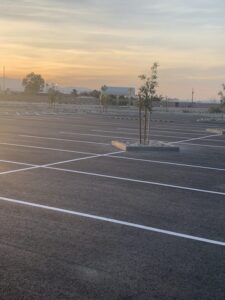
Asphalt Sealcoating Shortcuts a Contractor Should Never Take
 Asphalt is an economical choice for all types of pavements, including parking lots, busy highways, and city streets. Asphalt pavements are attractive, durable, and comparatively fast to install and maintain. However, neglected asphalt pavements can often fail before they achieve even a third of their expected life. Repeated studies have proven that periodic applications of a high-quality asphalt emulsion sealer can add years to a pavement’s life if included in a preventive maintenance program. However, unless the sealcoating procedure is performed correctly, the sealant will fail, leaving the pavement unprotected. Unfortunately, deliberately or accidentally, some contractors take shortcuts or deviate from correct guidelines.
Asphalt is an economical choice for all types of pavements, including parking lots, busy highways, and city streets. Asphalt pavements are attractive, durable, and comparatively fast to install and maintain. However, neglected asphalt pavements can often fail before they achieve even a third of their expected life. Repeated studies have proven that periodic applications of a high-quality asphalt emulsion sealer can add years to a pavement’s life if included in a preventive maintenance program. However, unless the sealcoating procedure is performed correctly, the sealant will fail, leaving the pavement unprotected. Unfortunately, deliberately or accidentally, some contractors take shortcuts or deviate from correct guidelines.
What Does a Proper Sealcoating Procedure Involve?
A proper sealcoating job involves much more than just spraying a sealant on the pavement. Asphalt contractors must prepare the sealcoating mix correctly, and they must have the tools and equipment to apply it properly. They must also ensure that the pavement is in a suitable condition to ensure that a strong bond will develop between the sealant and the pavement. Paving maintenance companies must also make sure that the weather conditions are within acceptable tolerances.
What Is a Correct Asphalt Sealcoating Mix?
Sealant manufacturers specify the recipe that asphalt contractors should use for each product. The basic recipe requires the contractor to combine the sealant, water, and sand in the correct proportions. If a contractor eliminates or reduces the sand in the mix, more water can be added to make the sealcoating cover more square feet. The resulting mixture will be too thin to provide proper protection. The sealcoating will wear away quickly, and the enhanced traction provided by sand in the mix will not be present.p
What Tools and Equipment Do Contractors Need to Apply Sealcoating?
The tools and equipment can vary by the job, but most parking lot maintenance companies rely on sprayers and squeegees to apply sealcoating. Sprayers are ideal for applying a sealant to a large pavement expeditiously and evenly. Squeegees are often reserved for the edges of the pavement and areas that cannot be successfully covered by a sprayer. To ensure that the sand particles remain evenly distributed, the contractor should have a mixer with a rotating drum. Without the right equipment, the contractor’s employees may be tempted to take shortcuts, including applying the sealant too thickly. One thick coat of sealant is not the same as two thin coats; thick coats will not cure properly, so the best you can hope for is an unattractive pavement that will need to be sealed again in just a few months.
How Do Parking Lot Maintenance Companies Prepare an Asphalt Pavement for Sealcoating?
If there are piles of sand or other debris on the pavement, contractors will typically perform a preliminary cleaning to expose any hidden damage. They will then repair any potholes, cracks, or further pavement damage. If they do not make the repairs first, the sealant will drain into the voids and be wasted. Next, the contractor will scrub any oil stains or apply a primer to them. This is usually followed by a scrupulous cleaning of the entire pavement just before they apply the sealcoating. Disreputable or inexperienced sealcoating contractors who are looking for shortcuts often skip the repairs, the cleaning, or both. The sealant never has a chance to form a bond, so the sealcoating job will need to be repeated within a few months if the pavement is to be protected.
What Are Acceptable Weather Conditions for Sealcoating?
There are several weather-related factors that can affect a sealcoating job, but some of them are not an issue in the Las Vegas area. However, the temperature is a critical one. Asphalt emulsion sealer should never be applied if the temperature is below 50 degrees. Furthermore, the temperature must remain above that point for at least 24 hours after the sealant is applied. Another factor that can sometimes affect Las Vegas sealcoating jobs is the wind. A slight breeze can help a sealant cure, but a high wind can disperse the sealant as it leaves the sprayer, resulting in areas that receive too little sealant and other areas that receive too thick a coat. Although not a common issue in the area, rain can ruin fresh sealcoating. Sealants need at least 24 hours to cure before they are subjected to rain. Contractors who are too impatient to wait for suitable conditions frequently deliver low-quality work.
Contact Affordable for Sealcoating Jobs Done Right
At Affordable Striping & Sealing, we specialize in parking lot maintenance for commercial clients throughout the greater Las Vegas area. We are a highly respected company providing exceptional results since 2006. Our services include parking lot design and layout, sealcoating, thermoplastic striping, traffic sign installation, asphalt crack repairs, bumper block installations, road striping and markings, and parking lot striping and marking. Call 702-222-9009 or fill out our online form to request a free quote.



